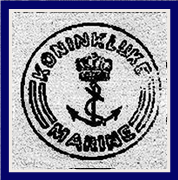
DUTCH INDONESIAN MEMOIRS 1941 - 1948
MLD Marine Luchtvaart Dienst
or
DNAS Dutch Naval Air Service
KONINKLIJKE LUCHTMACHT Netherlands Royal Air Force
HANGER 6 Naval Airstation Morokrembangan
Robert (Robbie/Bob) Hartman Kok
My fathers story 320Sq to 860Sq and 861Sq
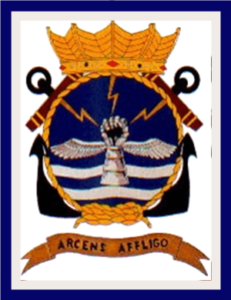
860Sq Arcens affligo
(Warding off, I afflict)
My father was born in Grisee (Grisik) 12 October 1924, to a privileged family with Dutch Indonesian parents. The family had lived in Indonesia since 1800. He attended good schools and was well educated. At the age of seventeen on the 26 August 1941, he signed on at Surabaja Naval Air Station as a cadet aged 17.
As we have read in the memoirs of Frank Rudebregt, Wim Versnell, John Franken and with a letter I received from Peiter Pijpaert (excerpts included in this story) he was with the cadets billeted in "Hanger 6" Morokrembangan Indonesia. With Frank we see them part ways in Durban South Africa. With Wim's memoirs we see them arrive in England from Durban and there on arrival billeted at Wrottesley Park Wolverhampton. Then the home of the Free Dutch Forces known as the Princess Irene Brigade.
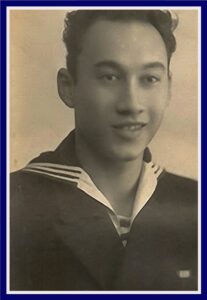
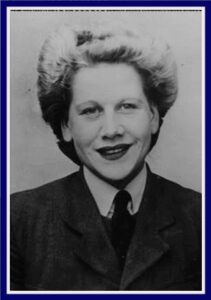
Robert Hartman Kok My father WAAF LACW Louis King
They met during my fathers time with 320 Squadron
Excerpt from Ktz Cor Smits 860 Squadron Swordfish Pilot
As a resident of the Dutch East Indies, the war started for Smits in December 1941. He was seventeen when the Japanese fleet razed the American bases at Pearl Harbour to the ground. On the 22nd of that month he would celebrate his eighteenth birthday, but six days earlier he received a present in the form of a call-up for the Royal Netherlands East Indies Army (KNIL). He liked it only moderately.
The accommodation was lousy and the food even less so. They ate well in the Navy, so when volunteers were asked, I signed up immediately. Some colleagues thought I was crazy, because the fleet had already suffered losses and the KNIL hadn't yet, but I didn't let it get me down. On New Year's Eve I left for Surabaya, where I was selected for the training as a candidate reserve officer (ARO).'
While Smits learned the tricks of the trade, the Japanese nibbled more and more pieces of the island kingdom. But military life went on as usual and so the AROs attended the obligatory church service at the beginning of March, after the lost battle in the Java Sea. When they returned to the Indies KIM that Sunday, everyone had flown.
“While enjoying a few neurotic Marine sergeants, we then loaded boxes of books and then drove to the Goebeng barracks, where it was complete chaos. From there we were evacuated by train to Tjilitjap."
To England
That evening the 'Kota Baroe' lifted the anchor after the necessary air raid sirens and finally dropped it again at the roadstead of Colombo (Ceylon, present-day Sri).
“Enys House”, was our training facility near Falmouth in Cornwall, however, was not finished with us yet, we spent three months more at “Pill Farm” where we were drilled and trained by Marines and British NCOs. It soon became apparent that there were too few available board placements, and they came to ask enthusiasts for other positions such as secret agent. Some of us even moved to the RAF. Others, like me, chose the Fleet Air Arm. They had had enough of Dutch pilots, because they had been evacuated from the Indies in time, but there was still a shortage of observers. I was part of the first team that started training in August '42. In May 1943 it was over and on June 1st we were posted to the new 860 Squadron presently in-formation."
A rather lighthearted film of the Royal Netherlands Naval College at Enys House
On the17 June 1942 my father was attached to the new version of Netherlands 320 Squadron Dutch Naval Air Service (DNAS) at RAF Bircham Newton, Norfolk. Operating under Coastal Command, Fleet Air Arm. 320 Squadron are on the offensive patrolling the North Sea with Hudsons. With the squadron are are members of Hanger 6 including Joop Besuijen, Wim Versnell, and Pieter Pijpaert who on leaving the DEI was 14 years old.
He stayed with the squadron during their conversion to Mitchells and their subsequent transfer from RAF Bircham Newton to RAF Methwold now under 2nd Group Bomber Command. On the 30 March 1943 the squadron moves again to RAF Attlebridge. Throughout the whole of this period, training in aircraft maintenance had continued for these young cadets and by now men.
From the 15 June 1943 events are taking shape that would affect my father's future and his continuation with the squadron. On this day 860 Squadron is formed at RAF Donnibristol, as a Royal Netherlands Navy manned Torpedo Bomber Reconnaissance squadron with six Fairey Swordfish Mark Is'. Two days later my father is sent to RAF Cosford for training.
At that time Cosford housed:
No 2 School of Technical Training--teaching airframe and engine fitters plus armourers all aspects of aircraft servicing.
No 9 Maintenance Unit--Assembling and storing Horsa Gliders and Spitfires from the Castle Bromwich factory.
No 6 Ferry Pool, an all women unit of the Air Transport Auxiliary responsible for the delivering the Spitfires to their intended units.
Pieter Pijpaert: Writes
"They continued their training, and your father was in this group. The leftovers including me stayed at Bircham Newton (320Sq base) to do the house keeping i.e. Cleaning barracks, kitchens, halls, Fire Crash Tenders, aids, just plain cleaned up the low skilled jobs no schooling needs. There where two groups in the Hangar 6 boys, big boys and small kids. Your father belonged to the big boys those over 17 years old, they were academic class educated, that's why your father spoke English very well compared to the other Hangar 6 boys of 1941."
"With the age difference they generally would rather not be together, but after 1943 due to the circumstances we all became equal and did the same work, technical training, and slept in the same barracks it really changed for the better."
Two further days on the 19 June 1943, 860 squadron leaves Donibristol. By the 23 June 1943 my father along with Joop Besuijen were the first group to finish their training at Cosford. Joop Besuijen is assigned to 321 squadron who were to be based in Ceylon flying Catalina's. My father returns to 320Sq whilst being put onto the London Roll, a roster for servicemen awaiting transfer.
On the 2nd of July his training now gives him the title "Aircraft-maker 2nd class". 17 days later on the 19 July, 860Sq arrives at RAF Haston in the Orkneys. My father receives his orders and by the 26 July 1943 is attached to Netherlands 860 squadron a truly sea-based squadron.
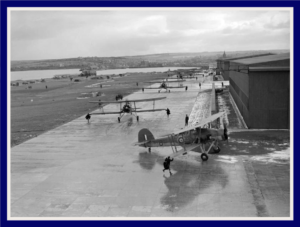
Royal Naval Air Station Haston
Pieter Pijpaert: Writes
"Your father was assigned to 860Sq / MAC duty which proves he belonged to the top 10 students of his class and was one of the first mechanics on a MAC of the Dutch Navy.
"After the first group finished their training the last group me included went to Cosford. After I finished training also with a good grade I to was assigned to the Macoma in about February 1943. I would rather have stayed with the kids of my own kind but orders where orders and I had to go. It was then that I once again met up with Bob (my father). The Macoma had three Swordfish and so required 6 mechanics, 3 for the power plant and 3 for the Airframe maintenance. We slept in the same room with me in the top bunk and Bob on the bottom. We didn't fly a Merchant flag but the Dutch national flag. We had merchant men onboard, but our commander was in charge of the ship."
The squadron is split into two flights "O" and "S" which are assigned respectively to the Acavus and Gadila. From January to April 1944 the Acavus embarked on convoy duty followed soon after by the Gadila with "S" flight from February to 15 May 1944.
Excerpt from Ktz Cor Smits
This squadron, which would eventually have three 'flights' - O, S and T - divided between the Macoma and Gadila and a British MAC. Incidentally, the MAC fleet also had grain ships in its ranks, whose flight deck measured about thirty feet shorter than the 420 feet of the tankers, but which sailed three knots faster, so about fifteen miles per hour. In addition, they had a hangar, while the tankers had to keep their aircraft on deck in all weathers. All MACs (except Macoma & Gadila ) flew the merchant flag and had eighty percent normal cargo on board. The two Shell ships had a crew of 115, of whom fifty were naval personnel: a flight officer, four Swordfish crews and ground and technical personnel. In order to be able to take off from the short flight deck, the biplanes were equipped with a fine pitch propeller, so that the life of the 690 hp Bristol Pegasus engine was a maximum of three months. Besides engines, '860' also wears out complete crates. Seventeen were lost during the war, the first of which was lost in a night-time anti-submarine warfare exercise in Scottish waters.
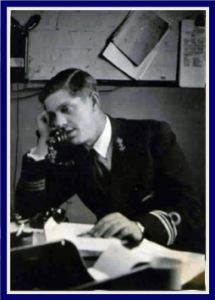

Lieutanant Commander 2nd Class Van der Tooren Macoma from the air taken by the third swordfish
Pictures Copyright Navy Kpt . Cor G Smits
"The commander, Lieutenant Commander, Second Class Van der Toorren, flew and Sergeant Van Dam was our telegrapher-gunner. We had to locate a towed target on the radar and then bomb it. One moment I was still in the aircraft, the next I was in the water. Apparently, we had hit the waves, there was quite a big sea, and I was catapulted out. Soon I ran into Van Dam, unconscious or dead, I don't know. The pilot was nowhere to be seen at first. The Swordfish had dragged him down, but he managed to break free and eventually I heard him scream. Meanwhile I tried to keep Van Dam above water, but every time I pushed him up, I went down myself. When I passed him on to Van der Toorren, he drifted off into the night and we never saw him again. Fortunately, a flashlight I had with me turned out to work and with it we finally caught the attention of a British destroyer, one of those ex-American four-pipe ships from the First World War. He picked us up."
My research shows that the serviceman who perished was Anton Gerhard Van Dam. he was born in Malang 1 November 1923 and died 24 October 1943 whilst carrying out Night Flying Training from RNAS Dunino, (HMS Jackdaw) Fifeshire, Scotland.
More information on Dutch Air Crew from both 320 & 860 Squadrons plus other casualties and their aircraft can be found at this excellent site "Lost Rob Philips Memorial Archive Index at,
http://aircrewremembered.com/LOST-rob-philips-memorial-archive-index-losses.html
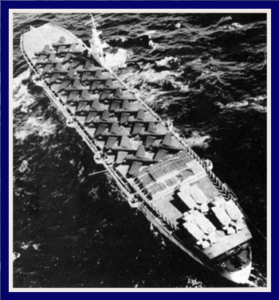
In a HX convoy returning from Halifax Nova Scotia 8000 tons US Navy Fuel Oil.
Swordfish aft, deck full with US warplanes and supplies bound for Greenock.
In the Swordfish, the crew of three sat one behind the other in open cockpits, with the operator the only one facing backwards, as he had to operate the .303 Vickers K tail machine gun. The other armament consisted of a Browning machine gun of the same calibre, which fired through the propeller field. In addition to one torpedo or four 250-pounders, the Mk II version equipped with '860' could also carry two four rockets fired from rails. The Swordfish had a flight time of over 4.5 hours, but in order not to defy the gods, patrol flights seldom lasted longer than two and a half. The fate of one crew, stationed aboard the British 'Acavus', served as a deterrent. Their torpedo bomber failed to overcome a headwind of 70 knots and was lost. In addition to the wind, the cold also played a major role.
'It happened that after a flight people had to be lifted from their coffins completely stiff. And then there was the suddenly looming fog. That happened to me once and we were able to land on a British MAC in the nick of time, because our own 'Macoma' had already been swallowed.'
The above film "Merchant Aircraft Carrier" shows a flight of 860 Squadron Swordfish from RAF Maydown Ireland joining the carrier in the Irish Sea. At the very start of the film there are two men one a Dutch Indonesian who I think but not convinced could be my father as it is only a quick glance as he turns to camera.
Nevertheless, despite the hardships and risks, there was also a lot to laugh about. For example, Smits tells of a kite who was known for his weak bladder.
“The Swordfish didn't have what we popularly called a 'urinal'. So that men always took an empty can upstairs. It took quite a while to fill it, but when he got it done, he threw the contents overboard. It happened that the observer just hung over the edge and then got the contents in his face. He didn't like it. Now you didn't have an intercom back then, but a mouthpiece that ended in the fly hood. So that observer hit back by hanging the mouthpiece in the slipstream, blowing the hood off the pilot's head.'
Such jokes and jokes were a welcome break from the usually extremely monotonous flights. Since the U-boat weapon was already on the decline in 1944, there was little to do and so it took a lot of effort to stay vigilant. Still, Smits thought he spotted a periscope together with the telegraph operator. Because they were flying at a low altitude because of the cloud cover, the missile attack failed. In time, however, escort ships arrived and took over the job. They were unable to make contact and then asked whether the Dutch had sometimes mistaken a whale for a submarine.
'The commander signalled back, 'If it was a whale, it must have swum on its back, because we clearly saw a periscope."
By the time these ships return the Macoma has been put into service and "O" flight transferred from the Acavus to the Macoma the Gadila's sister ship. My father is duly assigned on the 29th of May to the Macoma along with Pieter Pijpaert and sets sail once again for a convoy duty that would last until his assignment ended on the 27th of October 1944 just as "O" flight aboard the Macoma was redesignated "F" flight. It is said that the designation 860 "O" flight may have been to confusing. Both the Macoma & Gadila were converted oil tankers owned by Royal Dutch Shell with 461-foot solid wooden flight decks. The names are both types of seashell. Very apt one might say.
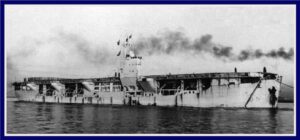
The Gadila
Pieter Pijpaert: Writes
"During sailing Glasgow - Halifax we were always together and at Halifax we were always together on shore while the Macoma re-fueled with oil, but when the Macoma de-bunkered her load of oil in Glasgow Bob never stayed with us Hangar 6 boys but went to England. If we asked, where are you going Bob? he would say to his girlfriend Louis.
The 860 squadron then transfers to RAF Dunino arriving on the 15 August 1943. On the 1 November my father is promoted to "Aircraft maker engine mechanic 1st class". Two days later the squadron transfers to RAF Machrihanish on the 3 November for weapons training. Here they are re-equipped with 12 Fairey Swordfish Mark II's. Once again the squadron moves, as on the 4 December 1943 the squadron is based at RAF Maydown, Ireland and are earmarked for operations aboard the Merchant Aircraft Carriers MV Acavus and the MV Gadila under the MAC ship wing which comprised mainly of No836 squadron.
Excerpt from Ktz Cor Smits
On yet another occasion there was no doubt whatsoever as to whether or not it was a submarine, for this time it sailed unconcernedly on the surface. Because of their slow speed, Swordfishes were not allowed to launch a solo attack on the heavily armed U-boats, but after enough aircraft had appeared, things went wild. The sub sank, but when a Canadian corvette picked up the lone survivor, it turned out to be a French boat. A tragic mistake due to the fact that the liaison officer of the escort group had forgotten to report the presence of the French.
My research shows that this was probably the FR Perle. Joined the Allies after the Allied landings in North Africa.
Sunk in error 8 July 1944, by British aircraft in the North Atlantic in position 55º27'N, 33º50'W while returning to Britain from the USA after refitting there.
During his time with the MV Macoma and Gadila father had performed convoy escort duty to Halifax, Nova Scotia, load with fuel oil and US planes, return to Greenock for offloading and back to RAF Maydown. The Swordfish having been stowed on deck therefore provided no air cover on the return trip. Whilst on lay over in Halifax my father a keen footballer played for the MV Macoma team against the New Amsterdam on the 18 July 1944. This ship was used to transport them three years before in 1941 from Ceylon to South Africa.
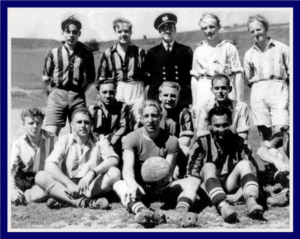

Team Macoma Macoma V Nieew Amsterdam Halifax Nova Scotia
Picture Copyright R D Hartman Kok Picture Copyright R D Hartman Kok
Shortly after this disembarkation he was promoted to "Aircraft Maker-Aircraft Mechanic 1st class" on the 1st of November 1944 and on the 14th December 1944 some 44 days after leaving the Macoma he was assigned to "S" flight aboard the Gadila and once again set sail for the Atlantic. This attachment would last until the 29 May 1945. However, I know the Gadila was docked in a homeport by 26 May as he was in Lewisham marrying my mother Louis on this day and by now his old friends in 320 squadron had been in Achmer Germany since the 30 April.
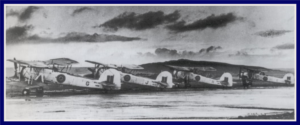
Netherlands 860 Squadron RAF Maydown Ireland
On average, the transatlantic crossing took 19 days. When the convoy approached Halifax, Canada, the Swordfishes flew to Dartmouth Airport. On departure for England we landed them again on board to move to their home base on Maydown near Northern Ireland. For Smits, that adventure came to an end when he was assigned for retraining on the Barracuda, which would succeed the Swordfish. Because of his experience, he soon gained the status of an instructor. The war in Europe ended during embarkation leave prior to deployment with a British squadron to the Far East.
On the 30 May 1945 the Macoma and Gadila ended their war time service and were de-commissioned after having completed approximately 30 Atlantic Convoys. The Squadron however had in part moved from RAF Maydown during my father's last trip across the Atlantic to RAF Machrihanish on the 14th May 1945 but this was only to last for one week until the 21st May.
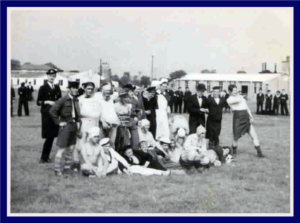
860Sq having fun in fancy dress football team 31 August 1945
Picture Copyright Navy Kpt . Cor G Smits
My father's service record shows strangely that he was detached for 7 days on the 18th of June to 25 June 1945 to the "Town" class destroyer HMS Leamington. However, the HMS Leamington at this time was the Russian ship " Zhguchi=(Fiery)" having been originally "USS Twiggs" until lend lease of 1940 and its transfer from the Royal Navy to Russia in 1944. It then returned to Britain to star in the 1952 film "Gift Horse" which depicts the St Nazaire raid. Starring Trevor Howard and Richard Attenborough.
On the 2nd of August 860 squadron was disbanded and three days later Indonesia was liberated however there seems to be no base of operations recorded during July and August. I can only presume the squadron was at sea on HMS Nairana or making its way to Ayr.
The squadron became entire once again transferring from RAF Maydown on to Ayr on the 30th of September 1945 having now given up their Swordfish aircraft and been re-equipped with 12 Barracuda III. which had been transferred in from 822 squadron. The squadron began to train with their new aircraft. New "old timers" and transferred servicemen began to swell the ranks of the squadron. On the 30th of October the squadron left Ayr for flight deck training which took place with the squadron aboard HMS Nairana which did not return to Ayr until the 15 November 1945.
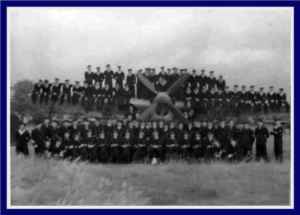
860 Baracuda Squadron
Picture Copyright Navy Kpt . Cor G Smits
This was a practice run and a precursor to the squadron becoming equipped with Dutch serialled Fireflies and the transfer of HMS Nairana into the Netherlands Navy on the 20 March 1946 to be re-named after the Admiral of the 'Battle of the Java Sea' "Karel Doorman".
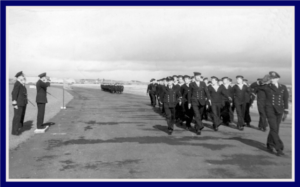
860 Squadron at HMS Fern (HMS Owl)
Picture copyright R D Hartman Kok
On the 19 April 1946 860Sq moved to the FAA land base HMS Owl in Fern Scotland newly transferred to the Royal Netherlands Navy. Now I know my father was at this base as I have photographs of him here so why his record does not show it, I do not know. However, the squadron leaves Scotland for the last time on 6th May 1946 and heads south to St Merryn Cornwall where the conversion to Fairey Fireflies is to begin. The Squadron is to stay here until the 27th June 1946.
Here the Squadron was to sail to the airbase at Morokrembangan Indonesia where all our memoirs started from. It would help in what the Netherlands called a Police Action against the native Indonesian population now engaged in its fight for independence from the Dutch Government. However, this move was not without controversy and an insult to some men of Hangar 6.
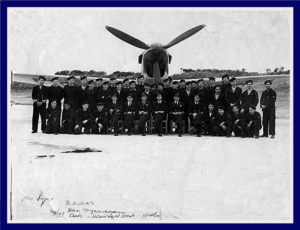
Netherlands 860 Squadron, Dale, Haverford West in Wales 1947. Father far right.
Picture Copyright R D Hartman Kok
From Frank Rudebregt's story:
'The 860 squadron was assigned to Surabaya Naval Air Station "Morokrembangan", but not for several others and me.
Orders came that the squadron was to be split and those who stayed behind were to form a new squadron.
I and all those who were born in Indonesia from mixed blood and all full-blooded Indonesians were to stay in England to form a "training squadron" and were sent to Pembroke, South Wales.
Politics or what, l did not know. The fact was that we did not sail home. About 90% of the crew, including officer pilots, left us. There were only a few "pure" Dutchmen, the commanding officer and three crew chiefs left behind.'
Now the squadron was split the bitter pill was that many would not return to their home. Speculation that the full or half Indonesian service men would be a risk was obviously on the minds of the Netherlands armed forces and Government. This underlying current of distrust would become reality to many Dutch Indonesians on leaving the confines of service to enter the Netherlands population.
So came the end of 860 Squadron in European waters. The Squadron had headed for Indonesia and the old airbase of Morokrembangan from where the Hangar 6 cadets, now men, once escaped. 860 Squadron stayed in Indonesia until 1950 when it was finally disbanded.
Those that were left behind came to form 861 Squadron at Dale Haverford west in Wales, on the 16 September 1945 as a Royal Netherlands Naval Squadron attached to the Royal Navy for work up. They were initially equipped with 4 Dutch Fireflies.
As for my father's service record it shows that he was not to go home but instead he was transferred at this time to RAF 701 Squadron on the 1 September 1946. My mother once told me he was at a Spitfire factory in London checking planes for re-equipping the Dutch Air Force. Having researched this, he was at the Fairy Aviation factory close by RAF Heston. He was being trained on the planes that were to be used by 861 Squadron and this ended on 22 December 1946. He was promoted to Corporal Aircraft maker-Aircraft Mechanic (Petty Officer) and re-assigned to Netherlands 861 Squadron 22 December 1946.
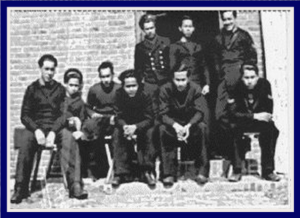
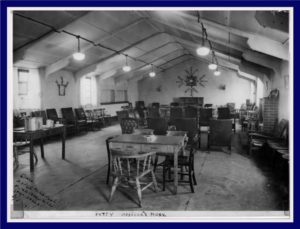
860 Squadron Indos not allow to go home Petty Officers Mess Dale Haverford West 3 March 1947
Back row 1. Veerman and 3. Pieter Pijpaert Picture Copyright R D Hartman Kok
Front Row left 1. Flickweert, 2. Frank Rugebregt, 3. My Father
Picture Copyright R D Hartman Kok
On the 14 April 1947 he received his transfer orders to report to the Naval Flying Camp Valkenburg. This would be the first time he had ever set foot in the Netherlands.
He was stationed onboard the new HNLMS Karl Doorman on 7 June 1947. The former named ship having been returned to the Royal Navy. His duties during this time ironically, were the training of new recruits to strengthen the Netherlands forces and pass on his knowledge to the new cadets.
He ended his service on the 1 November 1948 having served seven years and two months.
My father was never to return to his homeland ever again.
He had left his mother alone and all his family without a word of goodbye. So, what was their fate after seven years.
I once asked him years later "Don't you want to visit Indonesia again" His answer was "I don't want to end up dead". Another time he said "When you wear a uniform people respect the uniform and your service. Once you take it off, all they see is a coloured man in a white country."
Although he partook in the Battle of the Atlantic 1941-1945 only the Royal Navy gave a medal the Atlantic Star. The Netherlands Navy war department felt it did not warrant one.
He was awarded one medal by the Dutch Government the War Commemorative Cross with two bars. He threw it from the deck of a ship into the sea.
My thanks go to the men Frank Rugebregt, Wim Versnell, John Franken, Ktz Cor Smits and Pieter Pijpaert, crewmate who slept in the bunk below my father's onboard the ships.
Without these men and their memoirs and letters, I would have never known this important part of his life, it answered many questions about him. I would also thank all those who over the years have provided helpful correspondence about this period in history.